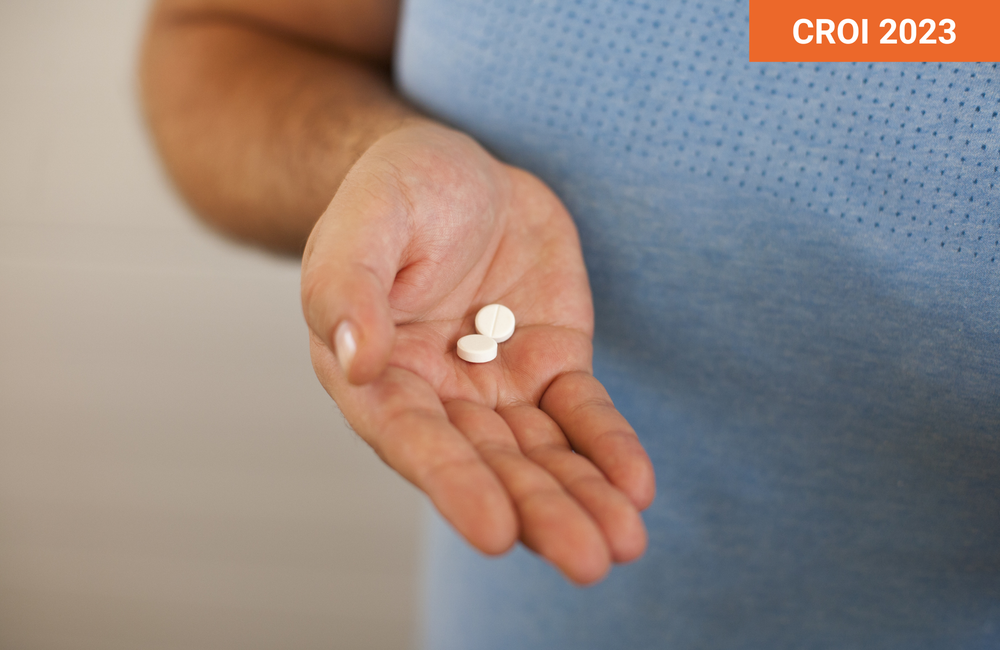
Weight loss after switching from tenofovir alafenamide (TAF) and an integrase inhibitor appears more likely in people with the highest body mass, two studies presented last week at the 30th Conference on Retroviruses and Opportunistic Infections (CROI 2023) suggest.
The combination of TAF and an integrase inhibitor (such as dolutegravir or bictegravir) has been associated with greater weight gain after starting antiretroviral treatment when compared to other combinations in several studies. In some cases this weight gain is substantial and people wish to switch away from the combination in the hope that this will lead to weight loss.
But few studies have looked at the metabolic effects of switching from TAF and an integrase inhibitor. A study of people who had participated in the ADVANCE trial found that people who switched from TAF to the older formulation of tenofovir (TDF) experienced a modest loss of weight after one year. Finnish researchers reported that weight remained stable over two years of follow-up in people who switched from TAF to TDF but continued to rise in people who stayed on TAF.
Two research groups reported on the impact on weight of switching from TAF and/or an integrase inhibitor at CROI 2023.
The ATHENA cohort study, which includes almost all people receiving HIV treatment in the Netherlands, reported observational data on changes in weight after switching from TAF. The analysis included 1440 people who had gained at least 7% of body weight within two years of starting a regimen containing TAF; 165 switched from TAF and/or an integrase inhibitor, of whom 69 had weight measurements available. Risk factors for weight change were compared between switchers and those who stayed on existing treatment after >7% weight gain (800 people with available weight measurements).
Those who switched treatment were predominantly male (79%) with a median age of 49, high CD4 counts (median 670) and median body mass index (BMI) of 25.7. Non-switchers did not differ significantly from the switch group.
Twenty-one people discontinued TAF, 37 discontinued an integrase inhibitor and 11 discontinued both TAF and an integrase inhibitor. Of those who discontinued TAF, approximately 80% switched to TDF, while those switching from an integrase inhibitor were evenly divided between those switching to a boosted protease inhibitor or a non-nucleoside reverse transcriptase inhibitor.
Those who discontinued TAF had gained a median of 3.2kg in the previous two years on TAF, while those who discontinued only an integrase inhibitor had gained a median of 5.9kg and those who discontinued both TAF and an integrase inhibitor had gained 5.6kg.
After switching, participants who discontinued each agent lost 1.3kg, 2.6kg and 1.7kg respectively.
In a logistic regression analysis, the only factor associated with greater weight loss after switching was having a BMI of 30 or above at the time of switching. People in this weight category (classified as clinical obesity) lost 5.4kg a year more than people in the normal weight range (BMI 18-24.9kg/m2) per year after switching. No new agent in the antiretroviral combination after switching was associated with greater weight loss.
Among those who continued treatment on their existing combination, the average weight loss 24 months after the first recorded weight 7% above baseline weight was -0.77kg.
At Ghent University in Belgium, the RUMBA study randomised 130 people on bictegravir / tenofovir alafenamide / emtricitabine or dolutegravir / abacavir / lamivudine to either switch to a dual therapy of dolutegravir / lamiuvudine (87) or take the bictegravir-based regimen (switching or remaining on it, 43 participants). The study population was 90% male with an average age of 46 years. Approximately 20% were of non-European ethnicity.
There were some differences between the randomised arms at baseline. Those randomised to dolutegravir / lamivudine had significantly higher average weight (81kg vs 75kg), waist measurement (95cm vs 89cm) and BMI (26 vs 22 kg/m2).
Forty-eight weeks after randomisation, those assigned to dolutegravir / lamivudine had significant although small differences in ALT, HDL cholesterol, lean trunk mass, trunk fat mass and total fat percentage favouring the dual therapy group. However, there was no significant difference in weight, waist measurement, BMI, total or LDL cholesterol, triglycerides, insulin resistance or liver stiffness between the two study arms.
When trunk fat mass was analysed by body mass category, the change from baseline was only statistically significant in those with a BMI of 30 or higher (p = 0.011). Those with a BMI of 30 or higher who were assigned to dolutegravir/lamivudine lost an average of 1kg while those on bictegravir / tenofovir alafenamide / emtricitabine gained an average of 1.4kg.
Dr Linos Vandekerckhove of Ghent University said that the study will continue to follow participants for five years to observe the evolution of weight and body composition. Longer-term follow-up may shed more light on the changes in weight in various body compartments and give further clues about mechanisms underlying weight gain.
Commenting on the presentations during a poster discussion session at the conference, Professor Donal O’Shea of University College Dublin’s Obesity Research Group said that from the perspective of weight management in diabetes, the changes in both studies were very modest, and “the clinical impact of that weight change would be considered minimal”.
Verburgh ML et al. Reversibility of TAF- and/or INSTI-associated weight gain. Conference on Retroviruses and Opportunistic Infections, Seattle, abstract 673, 2023.
View the abstract on the conference website.
Degroote S et al. Favorable metabolic outcomes 48 weeks after switch to DTG/3TC. Conference on Retroviruses and Opportunistic Infections, Seattle, abstract 672, 2023.
View the abstract on the conference website.
Update: This article was amended on 4 March 2022 to correct some details of the RUMBA study. In the study's second arm, participants remained on or switched to bictegravir / tenofovir alafenamide / emtricitabine, rather than all remaining on their existing treatment, as originally stated.
